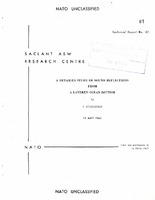| dc.contributor.author | Stangerup, Poul | |
| dc.date.accessioned | 2018-10-11T14:07:32Z | |
| dc.date.available | 2018-10-11T14:07:32Z | |
| dc.date.issued | 1965/05 | |
| dc.identifier | 2352 | |
| dc.identifier.govdoc | TR-42 | |
| dc.identifier.uri | http://hdl.handle.net/20.500.12489/340 | |
| dc.description.abstract | The effect of layered sediments on sound reflection from the ocean bottom has been investigated theoretically and experimentally. Very detailed, systematic and computer-aided calculations of the reflection coefficient of a twolayer bottom are made, using well-known theory and varying the following parameters: (1) velocity and density contrasts; (2) layer thickness normalized with respect to wavelength; (3) absorption in the sediments (in db/wavelength); (4) shear wave velocity in the lower layer. Calculations are made both for a harmonic source and for a broadband source analysed within certain bands around the harmonic source frequency. A series of curves is obtained representing the two-layer effect for a range of parameters that encompasses typical ocean bottom values. It is shown that absorption in the upper layer is of great importance in sound reflection, especially beyond a critical angle, but that moderate shear wave velocities have little effect. An octave band analysis of experimentaldata -- using a broadband source -- tends to support this theoretical two-layer model. | |
| dc.format | 44 p. : ill. | |
| dc.language | English | |
| dc.publisher | NATO. SACLANTCEN | |
| dc.relation.ispartofseries | AD0466138 | |
| dc.subject | Seafloor measurements | |
| dc.subject | Seafloor sediments | |
| dc.subject | Acoustic reflection | |
| dc.subject | Sediment shear waves | |
| dc.subject | Geoacoustics | |
| dc.subject | Shear waves | |
| dc.subject | Modelling and environmental measurements | |
| dc.title | A detailed study of sound reflections from a layered ocean bottom | |
| dc.type | Scientific Technical reports (TR) | |
